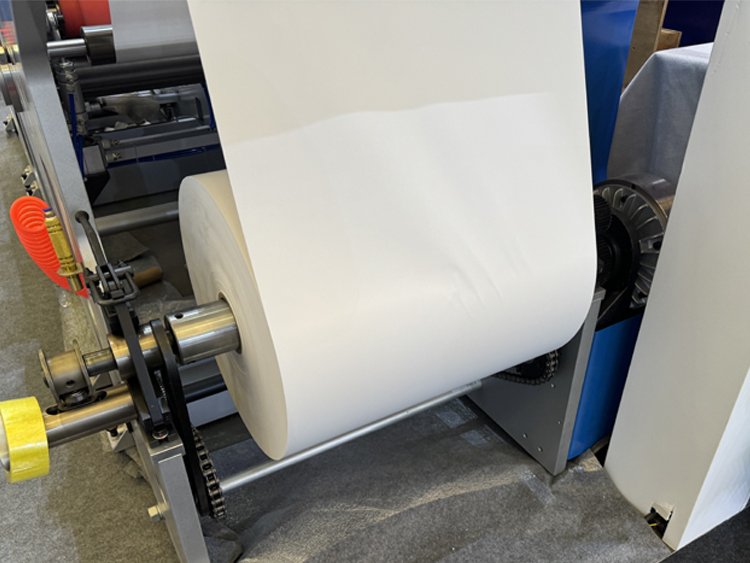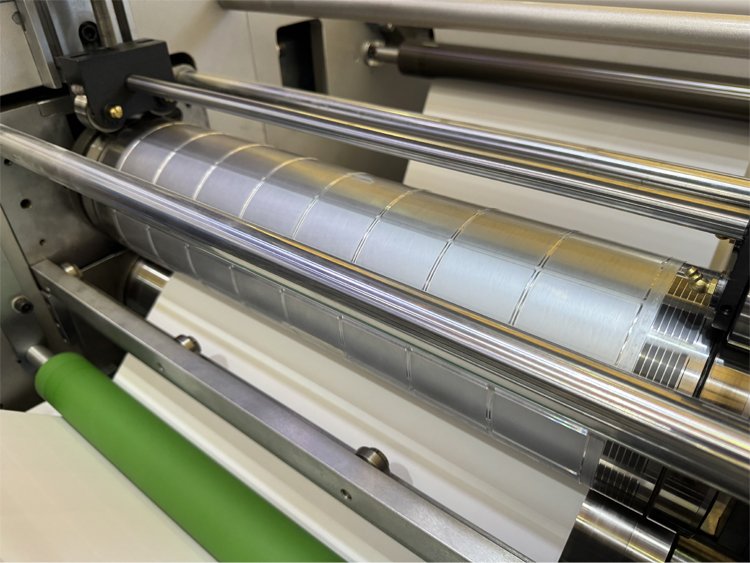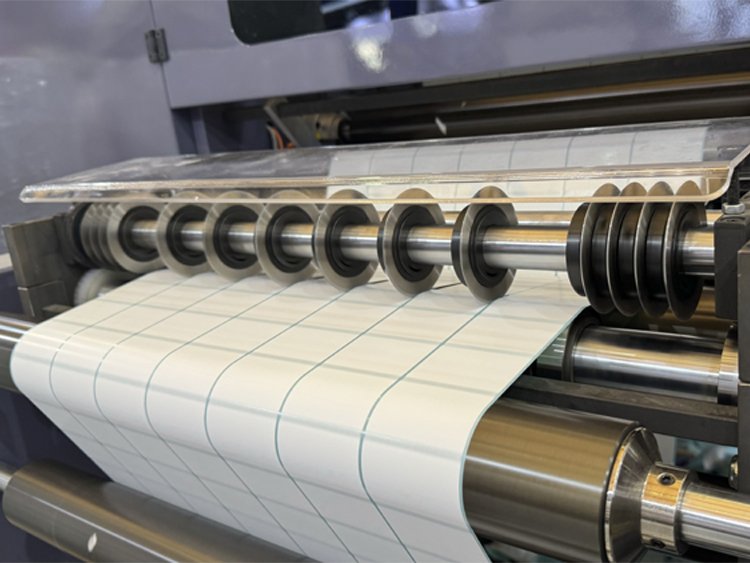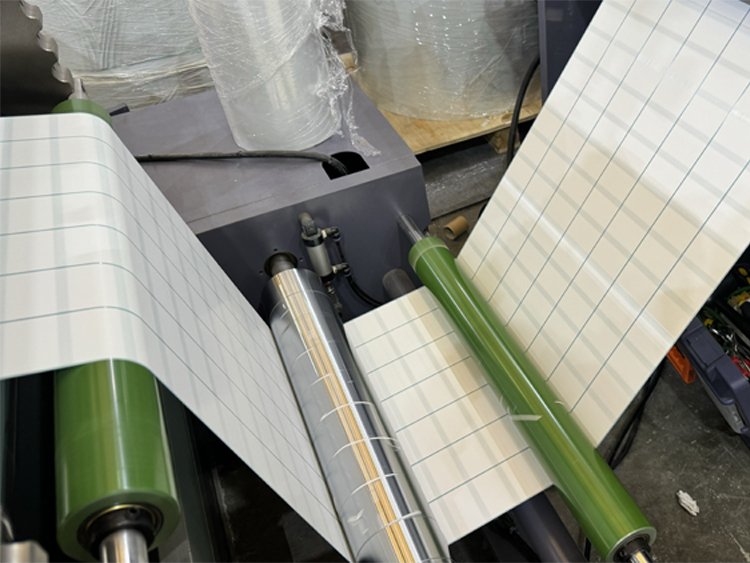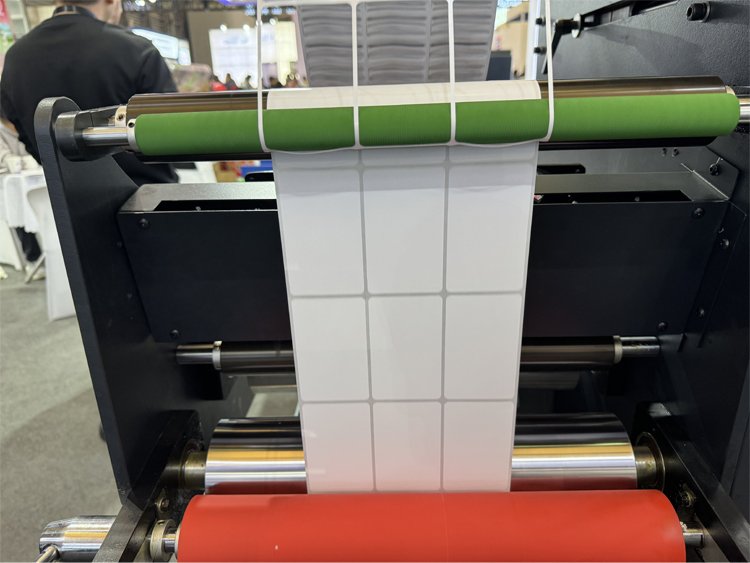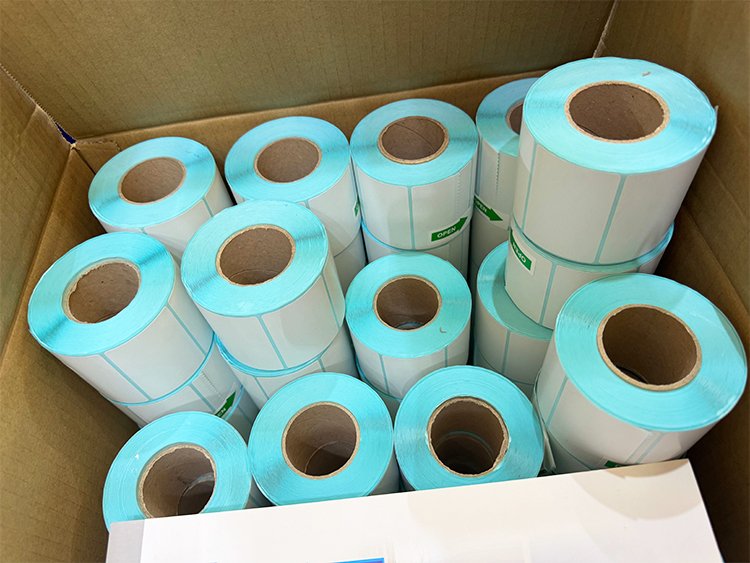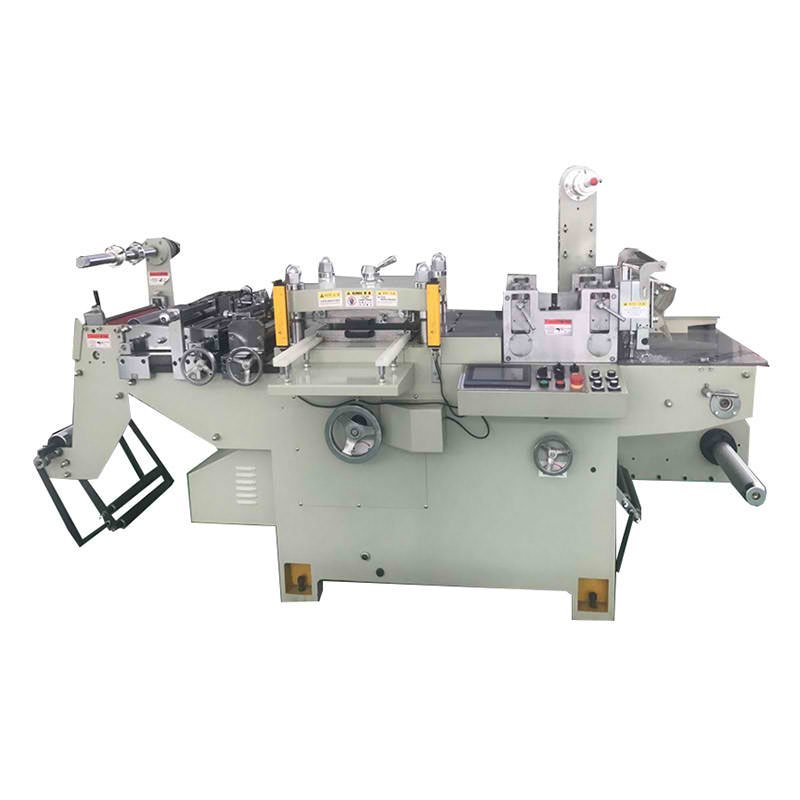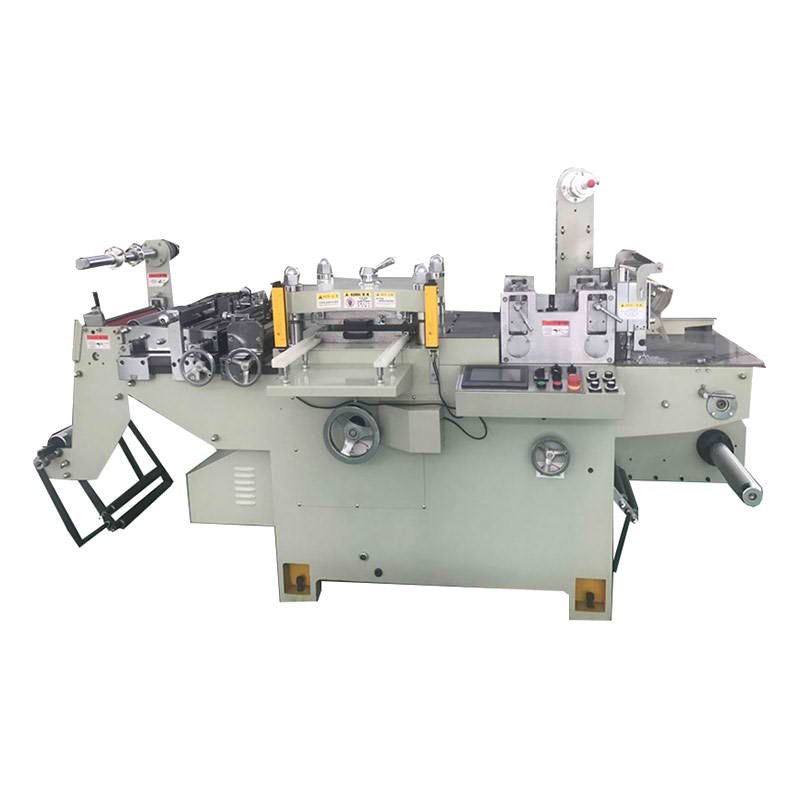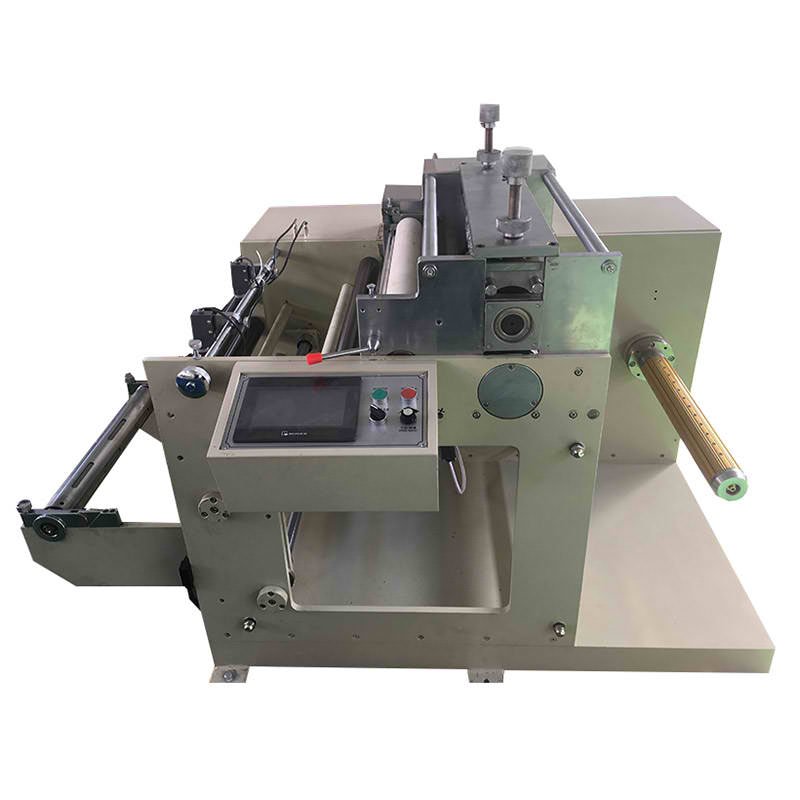JT-ADC-320G Rotary Die Cutting Machine
- Max. Unwinding Width 320mm
- Max. Unwinding Diameter 500mm
- Max. Rewinding Diameter 480mm
- Die-cutting repeat length 177mm-476mm
- Specification
- Video
| Item | JT-ADC-320G rotary die cutting machine |
| Max. Unwinding Width | 320mm |
| Max. Unwinding Diameter | 500mm |
| Max. Rewinding Diameter | 480mm |
| Die-cutting Repeat Length | 177mm-476mm |
| Max. Slitting Speed | 80m/min |
| Unwinding/Rewinding Shafts | 3” air expanding shafts |
| Total Weight | 750Kg |
| Overall Dimensions (L x W x H) | 1600mm x 1300mm x 1500mm |
| Specification |
| JT-ADC-320G rotary die cutting machine is suitable for handling blank adhesive labels. Die-cutting, laminating (optional), slitting can be finished in one process. |
| High accuracy rotary die-cutting system. |
| Automatic meter counting, automatic stop, web guiding by photocell. |
| Compact structure, fast speed, high efficiency, easy operation, accurate slitting and steady running, etc. |
| Main motor | 1.5Kw | Brand of Shanghai | 1 station |
| Inverter for adjusting the speed | 1.5Kw | Kewo China | 1 station |
| Blower | 0.37Kw | Brand of Shanghai | 1 station |
| Web-guiding photoelectronic sensor | DC 12-30V | YANGM | 2pcs |
| Web-guiding controller | Local | China | 1 set |
| Air shaft | Local | China | 3 sets |
| Synchronous motor | 90-115 | China | 1 station |
| Other equipment | Schneider | France |
JT-ADC-320G Rotary Die Cutting Machine
Last Update Time:02/01/2023
Typically, the 320G Rotary die-cutting and slitting machine is used to manufacture a large number of price tags or labels.
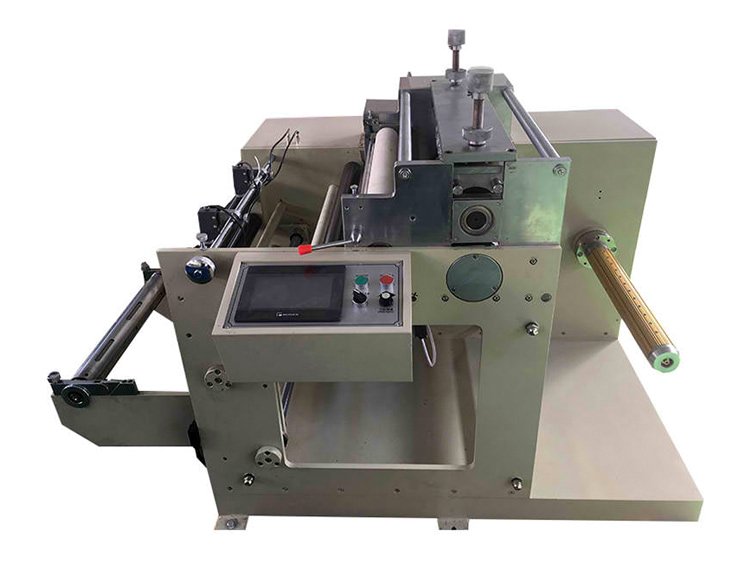
Blank stickers, after die-cutting and slitting, directly rewind to roll-by-roll price tags, which are widely used in supermarkets and warehouses.
If your die-cutting needs are not great and there are many categories, we recommend you consider our JT-ADC-320 flatbed die cut sticker machine.
Because each die-cutting size requires a die-cutting die, the cost of a flatbed die-cutting die will be cheaper.
If your die-cutting needs are relatively large (more than 1 million pcs), and the size is relatively single, you can consider our 320G rotary die-cutting slitting machine.
Although the cost of the die-cutting magnetic cylinder is relatively high (USD1200/pc), the speed is fast and the output is high.
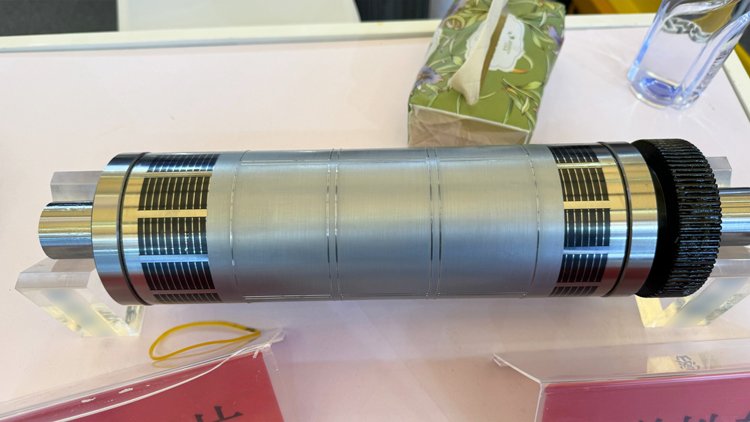
Die Cutting Magnetic Cylinder
We have many customers from the Middle East who bought these machines, they used it to produce self-adhesive price tags.
Pladent D.o.o. is our old customer. Starting from a JT-SLT-1300 slitting machine in 2008, we have had close cooperation for the past 12 years.
They mainly produce foam-type self-adhesive products, and the product sales network is spread throughout Europe.
Because of the particularity of the product, Pladent once asked us to help design a variety of die-cutting machines, involving flatbed, rotary, and multi-station die-cutting, rewinding, and laminating processes.
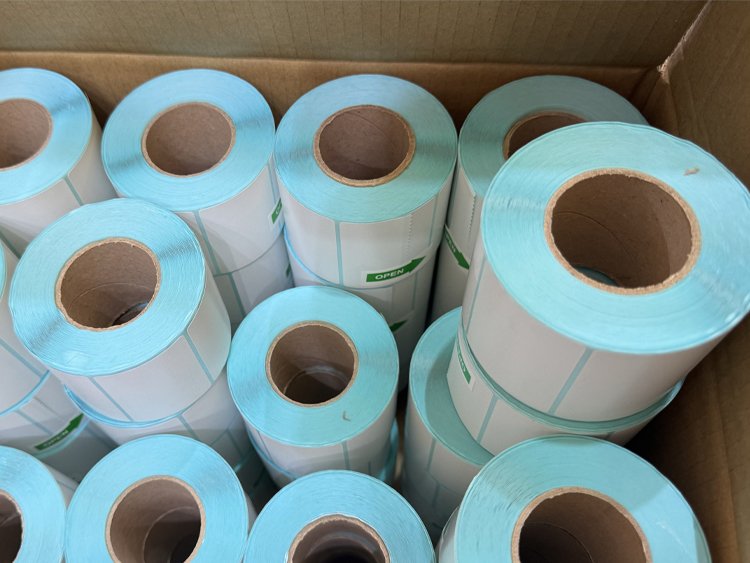
Each of their die-cutting machines is specially customized for them by us.
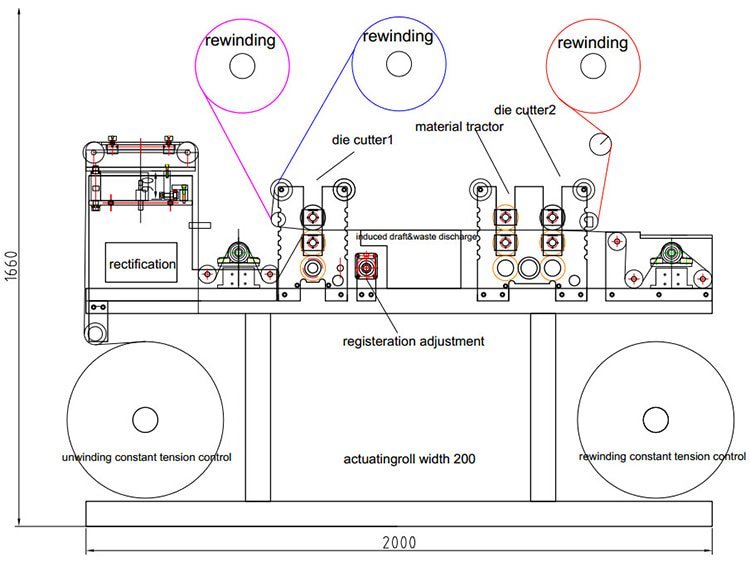
Die Cutting Machine Design Diagram For Pladent

Cutting Die Design For Pladent
Rotary die-cutting uses a circular magnetic cylinder, die-cutting dies are attached to it to perform high-speed die-cutting. The depth of die-cutting is determined by pressure, which can realize the kiss cut and full die-cutting.
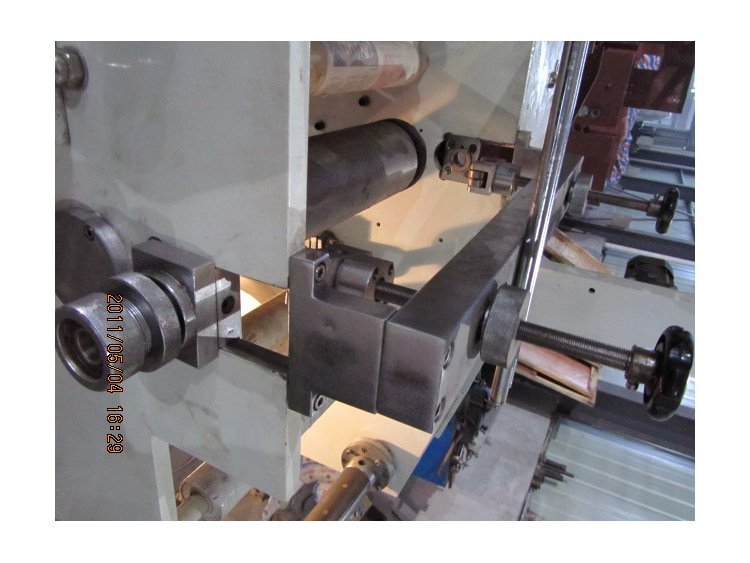
If the length of the die-cutting remains the same, it is not necessary to change the magnetic cylinder; instead, the die-cutting dies can be changed according to the pattern, which is very handy.
Historically, Pladent worked with an Italian supplier.
We are willing to work with him to design and optimize the machine according to his specifications, as we have a professional grasp of the machine itself.
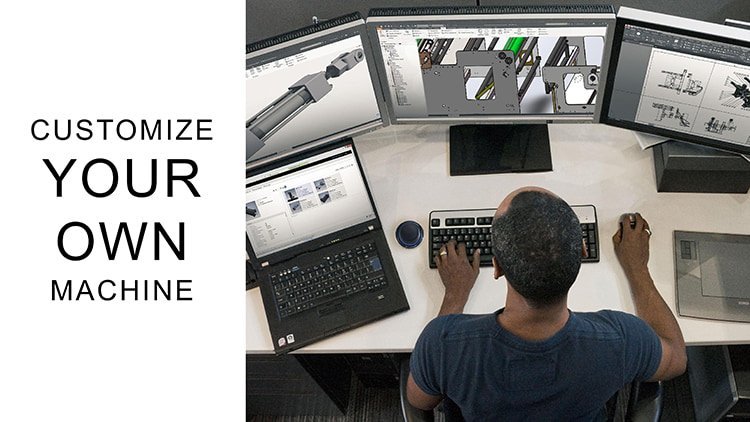
Now all the machines in his workshop are ours after working with us.
At the same time, they are also our live advertisements in Europe. If you are interested in our equipment or want to find a customer reference, you can contact Pladent.
If you are in Europe, especially Eastern Europe, and are interested in our equipment, welcome to contact us and visit Pladent D.o.o. in beautiful Slovenia.
Rotary Die Cutting Machine FAQ Guide
Rotary die-cutting is one of the most productive and cost-effective die-cutting techniques.
Adopting these services significantly simplifies the lives of physicians, engineers, and rocket scientists.
When determining whether die-cutting is appropriate for your project, the first question you will likely ask is what it is.
It is acceptable that many people are unaware of the benefits of die-cutting services.
This section will explain what die-cutting is and how it can help you with your particular project.
- Rotary Die Cutting Machine – An Introduction
- Manufacturing Process of Rotary Die Cutting Machine
- Raw material Required for Rotary Die Cutting Machine
- Printing with Rotary Die Cutting Machine
- Does It Harm the Environment?
- Rotary Die Cutting Machine Price
- Rotary Die Cutting Machine Supplier
- Purposes of using Rotary Die Cutting Machine
- Precision of Rotary Die Cutting Machine
- Difference between Rotary and Flatbed Die Cutting
- What Is a Semi Rotary Die Cutting Machine?
- Applications of Rotary Die Cutting Machine
- Benefits of Rotary Die Cutting
- Label-Making with Rotary Die Cutting Machine
- Advantages of Rotary Die cutting Machine
- Is Rotary Die cutting Machine Beneficial?
- Can I Engrave or Emboss with My Die Cutting Machine?
- Role of Die Cutting in the Packaging Industry
Rotary Die Cutting Machine – An Introduction
A die is a tool for cutting material into a specific form.
It is often constructed of metal and can be cut through paper, fabric, glue, and leather to achieve the desired shape.
It results in a large number of identically sized and shaped cloth or plastic cuts.
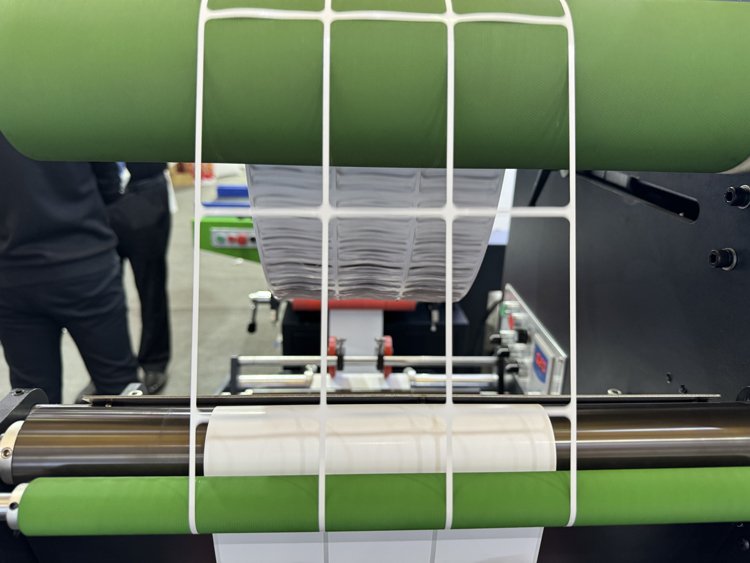
The process of die-cutting is done through machines. These machines can be handled manually, with the operator pushing a lever that causes the machine to cut through the material.
However, in today’s world, people like to use automatic machines as they are easy to operate and consume less time and energy.
This machine is a type of die cutting machine that involves cutting forms out of material with a cylindrical die.
It rotates in a circular motion and features blades that cut off the required shape around the cylinder.
It is highly efficient because it spins and cuts out many identical forms.
It is perfect for usage in areas like engineering, where metal and plastic sheets must be precisely the same size for a piece of equipment to function correctly.
It’s also necessary to manufacture adhesive sheets that fit on things of the same size, print bandages, and even make military equipment in the exact shape they require.
Manufacturing Process of Rotary Die Cutting Machine
Rotary die-cutting is a highly efficient method.
At Jota, a qualified professional will listen to your project’s requirements and develop and adjust a press specifically for you. Because Jota can customize the machines we employ to execute various tasks depending on the project at hand
In the rotary-cutting process, the rotary die cut machine uses large rolls instead of smaller sheets.
Jota’s rotary die-cut machine is fully automatic and uses plain or printed rolls to make die-cut labels, price tags, and stickers.
The whole process is automatic and reduces the manual aid. While in the case of the printed sheets, you may need to work manually alongside the machine’s working.
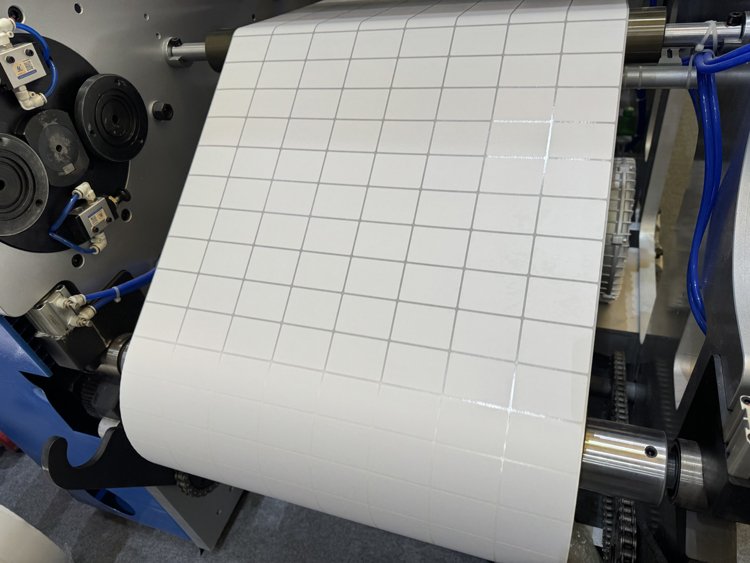
The large printed rolls of stickers are loaded into the feeder of the die-cutting machine.
The machine has a maximum 320mm unwinding diameter where it unwinds the label rolls.
It cuts the printed rolls with a speed of 80m per minute, which is favorable for high production.
The rolls slide into different cylinders, and the cutter cuts them into desired shapes of the labels and price tags.
Rotary die-cutting makes use of a circular magnetic cylinder with die-cutting dies connected for high-speed die-cutting. Pressure determines the depth of die-cutting, allowing for kiss cuts and full die-cutting.
If the die-cutting length remains constant, there is no need to replace the magnetic cylinder. Changing the die-cutting dies to match the pattern is very convenient.
Raw material Required for Rotary Die Cutting Machine
Die-cutting is most effective and popular on materials with low structural strength.
The most frequent materials used for die cutting are plastic and plastic films. Jota machines can also do die-cutting with foam, thin metal sheets, rubber, and fiber.
The material’s hardness will have the most significant impact on the types of die-cutting techniques that you can utilize. Because it can exert considerable force on the material, flatbed die-cutting is frequently used for more challenging materials.
Softer materials are more typically cut with water jet and laser cutting. Die-cutting is commonly employed in high-volume production, either to create finished items or portions of products.
Die-cutting can be used for a wide range of materials. Therefore, you can use it in a variety of production processes.
For Labels
Polypropylene film material, a form of plastic, is used to make film labels. As a result, they are a long-lasting and versatile label-class material.
Film labels are flexible enough to conform to and suit the shape of any product container. They are water and tear-resistant, as well as oil, UV, and fade-resistant. Film labels are a great, original products with distinct advantages that benefit you.
For Tags
Tags are non-adhesive labels that are connected to products by tying or hanging them.
They’re ideal for providing your customers with a one-of-a-kind experience.
Tags also provide enough room for information to be printed on both sides of your unique tag design.
Moreover, plastic films such as BOPP, CPP, and BOPET are also used as raw materials to manufacture the tags and labels.
Printing with Rotary Die Cutting Machine
The JT-DC-320G machine by Jota is a roll-to-roll cutting machine that can be equipped with an additional printing unit.
This machine is used for printing at a larger scale.
Jota’s machine has inline flexo printers for quick printing in many colors.
For this, raw paper rolls are put into the machines, and the machines are set up to make stickers with the right designs.
The rolls are then moved to the cutters, where real labels and tags with die-cut shapes are made.
Most of the inks used in flexo printing are water-based, which makes them easier to use and faster to dry. Making flexo printing plates is a simple process that you can quickly change to work with different materials.
Because of new improvements to inline flexo printing presses, flexographic presses can now compete with gravure and lithographic equipment in fields like making fiber-board packaging.
A flexo press uses water-based or UV/UV ink and takes less time to set up than a gravure press, so there is less waste. LED inks are a lot better for the environment than gravure inks.
Does It Harm the Environment?
Jota’s die cutting machine does not harm the environment in any way. It is entirely eco-friendly.
The chemicals used in manufacturing are less toxic than other manufacturing firms.
The raw material is also combustive. Furthermore, it does not release any harmful smoke into the air.
Rotary Die Cutting Machine Price
Its characteristics mainly determine the price of your machine. If you want to upgrade your die-cut machine’s features, the price will go up.
Adding a flexo printer to your rotary die-cutting production equipment, for example, can raise the price to a certain point.
The average cost of a cutting machine, on the other hand, ranges from $10,000 to $22,000.
Rotary Die Cutting Machine Supplier
There are plenty of rotary die-cutting machines suppliers all over the world. You can ask about the best suppliers from your friends and colleagues.
Search for their international relations with clients. You can also take help from Jota to reach an excellent cutting machine supplier.
Purposes of using Rotary Die Cutting Machine
The purpose of using a cutting machine is to stand by the market in the competition of making high-quality labels, tags, and stickers.
Jota ensures you a high-quality, fully automatic rotary cutting machine that can help you take your business to the utmost heights.
Precision of Rotary Die Cutting Machine
The rotary die cutting machine JT-ADC-320G can handle blank adhesive labels.
Die-cutting, laminating (if desired), and slitting can all be done in one step.
Rotary die-cutting has a system with high accuracy.
It has Photocell-guided web guiding, automatic meter counting, and an automatic stop.
Some advantages include a compact structure, high speed, high efficiency, simple operation, precise slitting, and steady running.
Moreover, the rotary die cutter can also work like a slitting machine and this quality has made it very popular among industrialists.
After die cutting, and slitting at the same time, it rewinds the paper into small bobbins. Sometimes, it also needs 2 positions to die cutters for some electric products or pharmaceutic products.
Difference between Rotary and Flatbed Die Cutting
The difference between the two types of die cutters is as under.
Rotary Die Cutting
Rotary die-cutting machines can make very complex multi-layer parts because they can do more than one thing during the same processing cycle.
Web materials are fed off unwind shafts as the material is pulled into the machine. From start to finish, materials can be laminated, cut, placed, and registered in the same way.
The webs are put in, and the finished pieces are taken out. Unlike die-cutting presses with a flat bed, there is no lost motion.
The material is chopped and processed between two cylinders that turn. Cutting speeds are measured in feet per minute and depend on how fast the material moves through the machine.
Most rotary die cutting machines use metal dies that have been cut by a machine.
An anvil is a roll that is shaped like a cylinder and is made with great care. To cut the material, a gear-driven die that has been carefully made is used.
Rotary die-cutting is a very accurate way to cut that is cheaper and wastes less than other methods when there are a lot of orders. A roll of material is put into the machine and then passed through the rolling die. The material is cut into the right shape, and trash goes into a catcher.
Flatbed Die Cutting
- A flat fixed base and a moving head are used in flatbed die-cutting machines.
- The cutting die is usually constructed of steel rule, which is a sharp metal strip bent to match the profile of the component to be manufactured.
- The bent steel rule is then inserted into slots in a plywood cutting board that are precisely aligned. The die can be attached to either the base or the head.
- Hydraulic pressure increases in a cylinder as the machine cycles, pushing the head with the cutting die through the material. Depending on the level of intricacy, the base could be a plastic cutting board, as seen in through-cut parts, or steel, as seen in precision flatbed die-cutting machines.
- Flatbed die-cutting, which uses steel rule dies, is an excellent choice for short-run orders where the cost of a rotary die is prohibitive.
- Finally, if just sheets of material are available, flatbed die cutting can be the sole option.
- Material shapes are stamped out using steel rule dies and hydraulic presses in flatbed die-cutting. This procedure facilitates the elimination of holes and webs from parts and short changeover periods, which improves efficiency.
There are numerous variations and options available for either rotary or flatbed cutting solutions.
A professional solutions-based die cutter will be able to set up the most cost-effective technique for your needs.
Keep in mind that, as technology and automation improve, what was once thought to be impossible may become a feasible production method in the future.
What Is a Semi Rotary Die Cutting Machine?
A semi-rotary die-cutting machine that works both manually and automatically.
You’ll have to exert extra effort while working with the semi-rotary machine as it consumes more energy.
As s result, it does not help you with high production, and your business target may reduce.
Applications of Rotary Die Cutting Machine
Let’s look at some of the applications of rotary die-cutting.
Medical Tools
In the medical field, rotary die-cutting for adhesive can solve a wide range of issues because it’s so adaptable and can be used to solve so many different concerns.
Rotary die-cutting machines can cut various materials, including waterproof adhesive and long-lasting cloth tape, for adhesive medical tape.
Die-cutting these tapes ensure that each piece is the perfect size and form to attach directly to a patient’s skin, allowing the wound to heal with the least amount of discomfort possible.
Protection
Surface protection is critical in almost all businesses, and rotary die cutters perform this function.
No one wants a car that has been scratched or dented because the automobile industry didn’t plan and utilize an anti-scratch and anti-dent glue.
Surface protectors are essential in the medical and scientific industries because they must be applied to tables where experiments are conducted.
Engineers must defend both the machines they develop and the machines they use to produce.
Thermal Masking
Cold temperatures cause several issues in a variety of businesses. When temperatures drop, machines in factories and construction zones shut down, and people use thermal masking.
For cutting this thermal masking tape, rotary die cutters are ideal. You can apply this tape to any smooth surface, including machinery, car windshields, and even the walls of workplaces.
It will ensure that, even in subzero temperatures, both machines and people continue to work correctly.
Benefits of Rotary Die Cutting
Rotary die-cutting uses a rotary press to cut or perforate the desired shape out of flexible material.
In general, rotary die-cutting is beneficial for:
- Projects with a high volume of consistent cuts
- Products with a smaller size
- Using a web to cut items (continuous roll)
- Produces less waste than other equivalent technologies
- Precision cutting with a tight tolerance
- Quick response times
- Multiple process projects – rotary die-cutting can be combined with printing, embossing, laminating, and other processes.
Moreover, Rotary die presses enable high-speed conversation of a variety of flexible materials with constant accuracy.
Rotary die presses can be configured to die-cut, also laminating, score, and sheeting in the same operation.
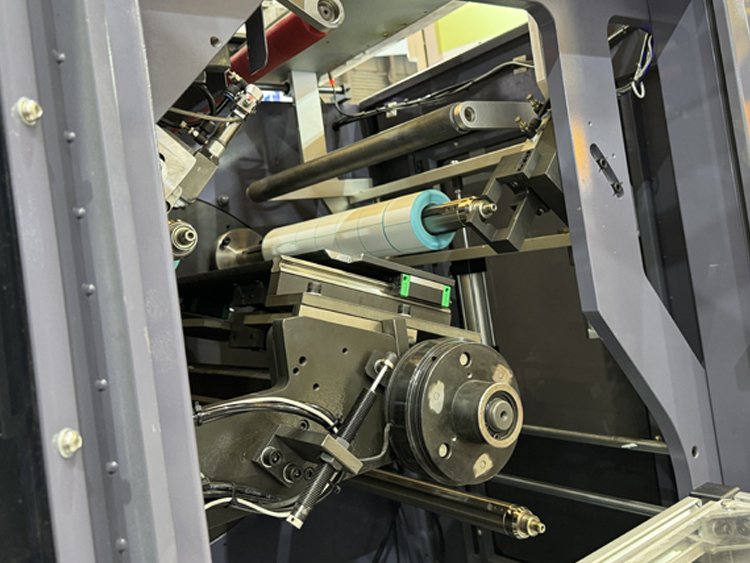
The material’s breadth, the size of the rolls, and how many operations may be built into the production process can all be determined by the web width of the rotary die press.
Both the fabrication and rotary die-cutting of parts necessitate meticulous planning and engineering.
Label-Making with Rotary Die Cutting Machine
In the worlds of business and industry, die-cut labels are in the seventh sky.
These labels can be made using a variety of printing techniques and have a wide range of uses.
You can use a variety of ways to print on die-cut labels.
Direct thermal printing, which employs a thermal printhead to apply heat to a chemically prepared surface such as paper, which turns black where the heat is applied, is widespread and less expensive.
Printing in black and another color, such as red or blue, is possible using two-color printers. Because extra heat or light might cause the heat-sensitive material to darken, rendering labels unreadable or barcodes unscannable.
This technology is appropriate for short-term barcode applications like name tags, shipping labels, shopping labels for meat packages, and receipts.
You can also print these labels with Inline Flexo printed pre-installed in the Jota rotary die cutting machine.
Advantages of Rotary Die cutting Machine
Although all types of die-cutting have advantages, a rotary die cutter has various advantages that put it ahead of the competition.
- Rotary die-cutting machines can cut through almost any material at high speeds, from paper and magnets to foam, metal, and cork.
- Rotary die-cutting is an ideal alternative for finishing big production runs because of its speed and efficiency. Because the machine’s cutting pattern is pre-programmed, it doesn’t need to be modified between cuts, allowing it to process vast volumes of material with minimal mistakes.
- The effectiveness of rotary die-cutting makes it simple to transport materials from concept to finished product.
- As rotary die-cutting duplicates exact cuts, you can be sure that each item you manufacture is similar to the one before it.
- It’s the most precise die-cutting alternative, which is why it’s frequently chosen for large-scale production runs that demand accuracy and uniformity.
- Die-cutting produces less waste than other methods, making it both more cost-effective for the company and more environmentally friendly.
- Rotary die cutters can do various things depending on the project, including laminating, kiss cutting (to make adhesives), embossing, and more. They can even do inline packaging if necessary.
- Rotary die-cutting machines use simple methods that result in minimum component wear and tear.
Is Rotary Die-cutting Machine Beneficial?
Due to the multiple advantages of rotary die cutters, jota has benefited many foreign consumers.
Furthermore, using a Jota rotary die-cutting machine to make die-cut labels and tags could earn you a lot of money.
As a result, individuals all around the world benefit from using this technology.
Can I Engrave or Emboss with My Die Cutting Machine?
Cutting machines, both manual and computerized, can cut various materials with great precision, but they’re not just for cutting out shapes and stickers.
Depending on the machine, some machines can engrave, emboss, add foil transfers, and even write envelopes for you.
Difference between Die Cutting and Embossing
Die-cutting involves cutting paper and other materials, whereas embossing requires shaping the material into a precise shape that changes its dimension.
Embossing folders and die-cutting go hand in hand because particular embossing folders require a manual die-cutting machine.
Die-cutting is a high-precision cutting procedure that uses a manual or digital die-cutting machine to cut forms from a material.
Embossing is a decorative method for adding texture to a pattern by raising parts of a material.
Role of Die Cutting in the Packaging Industry
Die-cutting is a procedure that involves using machines or steel-cutting die plates to shape and dimension a thin flat sheet of various materials.
Die-cutting allows for the creation of nearly any type of packaging, regardless of size, material, fold, or function.
This flexibility and breadth of packaging options improve your company’s fulfillment operation significantly. The approach assures design accuracy while also allowing for high-volume production.
Die-cutting techniques, machines, and styles are diverse, allowing for a wide range of packaging functions. This feature distinguishes custom packaging from regular packaging, opening up a world of possibilities.
Packaging boxes have evolved into a simple approach for producers to provide services.
With a variety of kinds, including die-cutting boxes, it has provided visual comfort.
In order to let you know more about we Jota company, please watch the following video for reference.
We Jota could also supply the following related machines, if you are also interested in any type, please feel free to send us an inquiry:
- Hot Melt Thermoplastic CFRP CFRTP Prepreg Manufacturing Machine
- Fully Automatic Thermal Paper Roll Slitting Packing Machine
- Fully Automatic Toilet Paper Maker
- Automatic Facial Tissue Making Machine
- Plastic Film, Fabric, Aluminum Foil Slitting Rewinding Machine
- Paper Sheeter
- Paper Tube Making Machine
- Paper Drinking Straws Machine
- Flexo Printing Machine
- Cardboard Tube Cutting Machine

